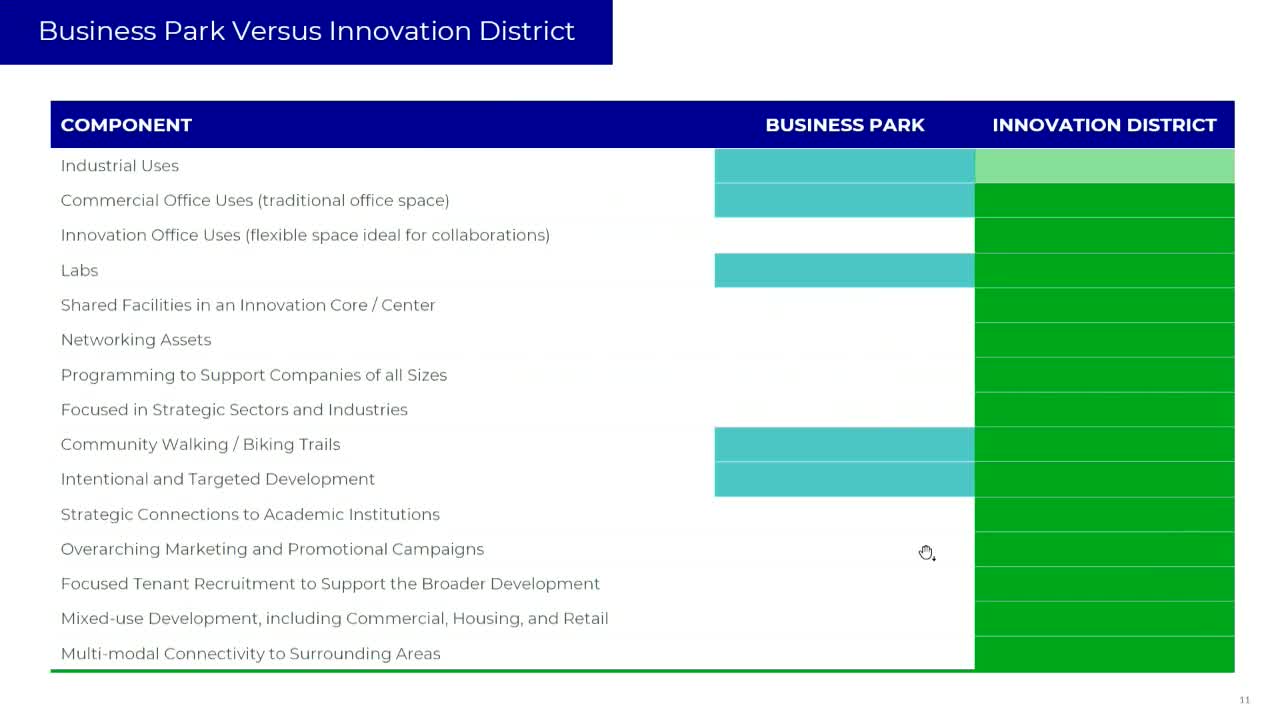Gateway Innovation District Plans Focus on Cybersecurity and Emerging Industries Growth
September 08, 2025 | Howard County, Maryland
This article was created by AI summarizing key points discussed. AI makes mistakes, so for full details and context, please refer to the video of the full meeting. Please report any errors so we can fix them. Report an error »

On September 8, 2025, Howard County officials convened to discuss the transformative vision for the Gateway area, aiming to establish it as an Innovation District. This initiative seeks to enhance economic growth by fostering a collaborative environment for businesses, academic institutions, and government entities.
The meeting highlighted the distinction between traditional business parks and innovation districts. While both serve employment purposes, innovation districts are designed to address common challenges faced by businesses, such as resource access and talent development. They create a vibrant community where various stakeholders can co-locate, facilitating partnerships that drive innovation.
Key discussions centered around the existing conditions of the Gateway area, which spans 1,100 acres and includes a mix of commercial, industrial, and undeveloped land. Currently, about 73% of the area is zoned for light manufacturing, but only 25% is utilized for industrial purposes. The plan aims to leverage Gateway's strategic location near major roadways and proximity to key assets like the Maryland Innovation Center to attract new industries, particularly in cybersecurity, defense, and technology.
The proposed master plan outlines a vision for Gateway as a mixed-use community that prioritizes walkability, sustainability, and connectivity. It emphasizes the creation of open spaces, urban plazas, and a linear park to enhance public engagement and foster a sense of community. The plan also includes recommendations for integrating residential developments, with a projected demand for thousands of multifamily units over the next 30 years.
Officials underscored the importance of flexibility in zoning and development standards to adapt to changing market conditions. The plan encourages a mix of residential and commercial uses, with specific areas designated for higher density development to create vibrant urban nodes.
In conclusion, the Gateway Innovation District represents a significant opportunity for Howard County to redefine its economic landscape. By fostering collaboration and innovation, the plan aims to create a thriving community that meets the needs of its residents and businesses alike. As the planning process continues, stakeholders will need to navigate various challenges, including zoning regulations and market dynamics, to realize this ambitious vision.
The meeting highlighted the distinction between traditional business parks and innovation districts. While both serve employment purposes, innovation districts are designed to address common challenges faced by businesses, such as resource access and talent development. They create a vibrant community where various stakeholders can co-locate, facilitating partnerships that drive innovation.
Key discussions centered around the existing conditions of the Gateway area, which spans 1,100 acres and includes a mix of commercial, industrial, and undeveloped land. Currently, about 73% of the area is zoned for light manufacturing, but only 25% is utilized for industrial purposes. The plan aims to leverage Gateway's strategic location near major roadways and proximity to key assets like the Maryland Innovation Center to attract new industries, particularly in cybersecurity, defense, and technology.
The proposed master plan outlines a vision for Gateway as a mixed-use community that prioritizes walkability, sustainability, and connectivity. It emphasizes the creation of open spaces, urban plazas, and a linear park to enhance public engagement and foster a sense of community. The plan also includes recommendations for integrating residential developments, with a projected demand for thousands of multifamily units over the next 30 years.
Officials underscored the importance of flexibility in zoning and development standards to adapt to changing market conditions. The plan encourages a mix of residential and commercial uses, with specific areas designated for higher density development to create vibrant urban nodes.
In conclusion, the Gateway Innovation District represents a significant opportunity for Howard County to redefine its economic landscape. By fostering collaboration and innovation, the plan aims to create a thriving community that meets the needs of its residents and businesses alike. As the planning process continues, stakeholders will need to navigate various challenges, including zoning regulations and market dynamics, to realize this ambitious vision.
View full meeting
This article is based on a recent meeting—watch the full video and explore the complete transcript for deeper insights into the discussion.
View full meeting
